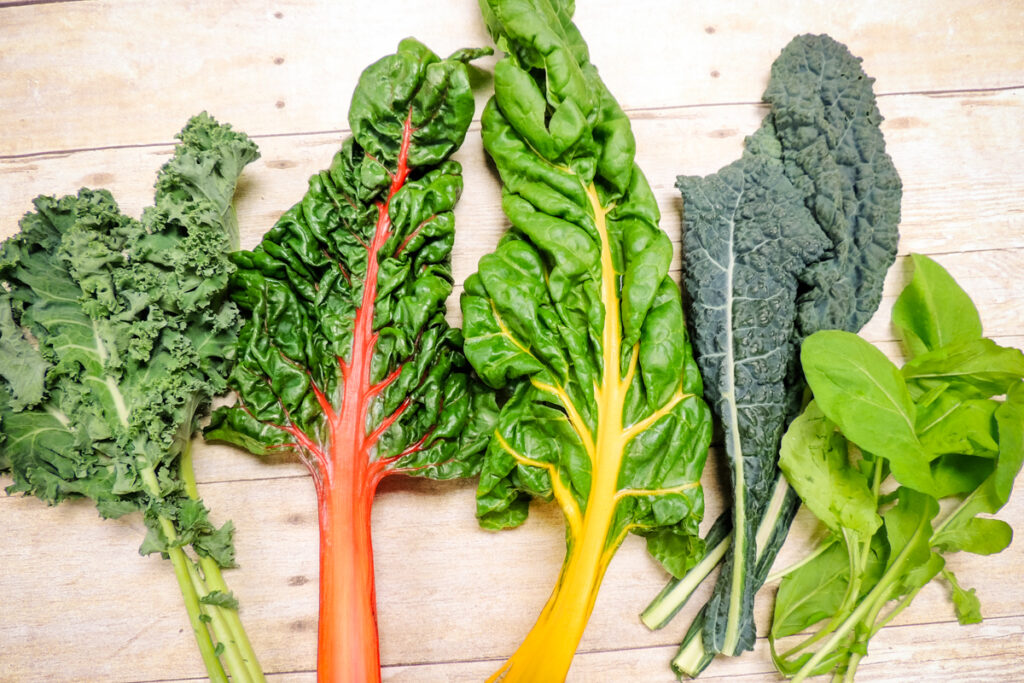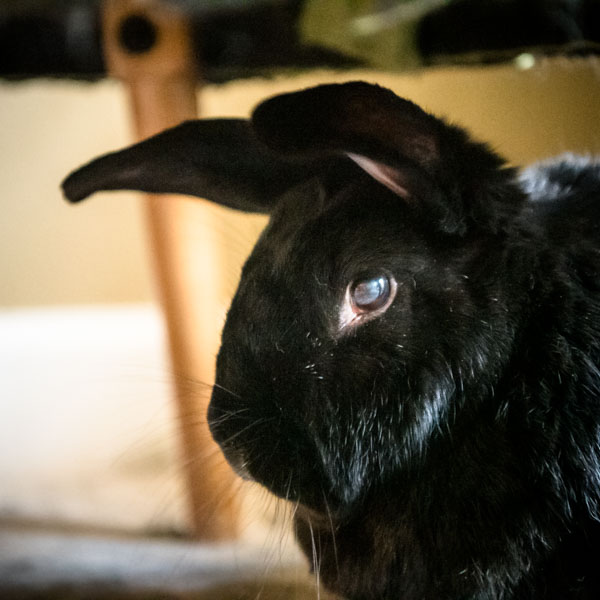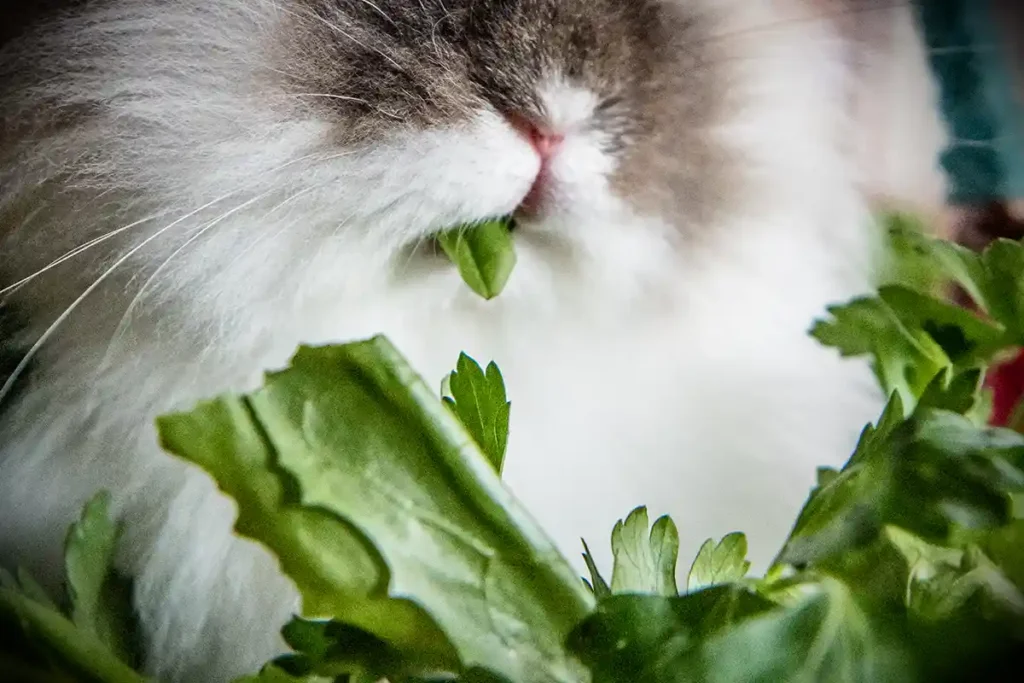Fresh vegetables should make up approximately 10% of your adult rabbit’s diet. Hay should consist of 80% of your rabbit’s diet. Fruits should be considered a treat and be less than 5% of your bunny’s daily diet. Read on for more details about the role of fruits and vegetables in your rabbits’ diet
Vegetables provide additional nutrients and different textures and tastes — an enriching experience for your rabbit. Wet vegetables are also a good source of water if your bunny does not drink very much from his water bowl or bottle.
Amount of Vegetables to Feed Rabbits
For baby rabbits, vegetables should only be fed after 12 weeks of age and introduced one at a time in quantities under 1/2 oz.[1] Exceptions may apply if the baby rabbit has already been introduced to those specific vegetables while living and weaning from their mother, as their digestive system is already used to the food. The age minimum is important as baby bunny digestive systems do not finish developing until around 8 weeks of age, and an upset stomach can easily cause diarrhea or fatal enteritis that requires emergency veterinary care in a baby bunny.
For adult rabbits, a good rule of thumb is approximately one cup of packed greens for every two pounds of rabbit.[2] You may decide to feed more or less but keep an eye out for any change in litter habits and behavior.
Generally, rabbits are good at self-regulating when given a giant pile of fresh dark greens. No lasting harm will be done if you offer more than the recommended amount. Too many vegetables for some rabbits may cause runny stools and diarrhea. These bunnies should have their greens portioned strictly. Smaller dark poops can also indicate that the rabbit should eat more hay for more fiber in their diet.
Some vegetables may cause diarrhea or stomach upset for some rabbits. If you are introducing new greens to a bunny, introduce only one type one day. This way you can easily tell if the food will not agree with your bun. Wait 24 hours to make sure there are no soft stools or gas problems before adding another vegetable to your rabbit’s diet. If the droppings are soft or the rabbits are gassy, discontinue the vegetable to prevent more serious gi stasis issues.
Be aware that every rabbit is different, and it is up to you to find the right balance for a healthy bunny. Some rabbits may not react well with greens, especially those that may suffer from megacolon and can thrive on a pellet/hay-only diet.[3]
Serve your vegetables wet to increase your rabbit’s intake of liquid. It will help keep his GI contents moving.
Do not serve your bunny spoiled vegetables. If you wouldn’t eat it yourself, don’t feed it to your bunny. Rabbits can be even more sensitive to spoiled food than humans.
Rabbit Safe Vegetables
Care should be taken when feeding some of these, as some vegetables may cause issues in some rabbits. Vegetables with a high water content can cause diarrhea and runny stool. Other vegetables contain higher amounts of sugar and should be fed only in moderation as a treat.
There are vegetables and flowers that a bunny should not eat and are covered in the Vegetables to Avoid section below. Detailed nutrition for rabbit-safe vegetables can be found at Fruit and Vegetable Nutrient Data on WabbitWiki.
Should I avoid feeding vegetables such as broccoli and cabbage to my rabbits?
Some vegetables, such as broccoli and cabbage, can cause issues in humans — however, this concern does not extend to rabbits. As Dr Susan Brown writes1,[2]
A rabbit’s GI tract is not the same as a human’s and many of the foods that may cause gas in a human do not cause gas in a bunny…
There has also been discussion about feeding vegetables that are goitrogenic in humans (causing a goiter) more notoriously those in the broccoli/cabbage family. One study done on rabbits indicated that it would take several weeks of exclusively feeding huge quantities of these foods to see any abnormalities in the blood. This is so far removed from normal feeding instructions for rabbits that there is no cause for concern in feeding these nutritious foods.
Leafy greens

Leafy greens should make up approximately 75% of the fresh vegetables fed daily.[2]
The following list contains leafy greens known to be safe for rabbits to eat.[2][4][5][6][7][8][9]
- Arugula (Eruca sativa)
- Basil (Ocimum basilicum)
- Beets tops/greens (Beta vulgaris)
- Bok choy / Pak choi / Pak choy (Brassica rapa subsp. chinensis)
- Borage leaves (Borago officinalis)
- Buckwheat leaves (Fagopyrum esculentum)
- Cabbage (Brassica oleracea) – Too much can cause enlargement of the thyroid and digestive problems.[8]
- Red cabbage (Brassica oleracea var. capitata f. rubra)
- Savoy cabbage (Brassica oleracea convar. capitata var. sabauda L.)
- Carrot tops (Daucus carota)
- Cassava greens (Manihot esculenta)[10] – has a high protein content like alfalfa; feed sparingly.
- Chicory greens (Cichorium intybus)
- Witloof / French endive / Belgian endive
- Collard greens (Brassica oleracea var. Acephala)
- Coriander / cilantro (Coriandrum sativum)
- Cucumber leaves (Cucumis sativus)
- Dandelion greens (Taraxacum officinale)
- Dill leaves (Anethum graveolens)
- Endive (Cichorium endivia)
- Escarole (Cichorium endivia var. latifolia)
- Fennel (Foeniculum vulgare) – leafy tops and base. Seeds have been reported to cause stool issues.
- Fenugreek (Trigonella foenum-graecum)
- Gai choy / Gai choi / Mustard greens / Kai choi (Brassica juncea)
- Goutweed (Aegodopium podograria)
- Kai lan / Gai lan (Brassica oleracea var. alboglabra)
- Kale (Brassica oleracea var. acephala)
- Komatsuna / Mustard spinach (Brassica rapa var. perviridis or komatsuna)[11]
- Lamb’s quarters / White goosefoot (Chenopodium album)
- Lettuce (Lactuca sativa)
- Butterhead lettuce
- Cos lettuce
- Frisee lettuce
- Green leaf lettuce
- Red leaf lettuce
- Romaine lettuce
- Lollo rosso lettuce
- Lollo lettuce
- Mache / corn salad (Valerianella locusta)
- Mint (Mentha spp.) – some plants in the mint familyLamiaceae may be toxic
- Apple mint (Mentha suaveolens)
- Chocolate mint (Mentha × piperita)
- Orange mint (Mentha citrata)
- Peppermint leaves (Mentha × piperita)
- Pineapple mint (Mentha suaveolens)
- Spearmint (Mentha spicata)
- Mustard greens (Brassica juncea)
- Napa cabbage / Pe tsai (Brassica rapa subsp. pekinensis)
- New Zealand spinach (Tetragonia tetragonioides)[12]
- On choy / Water spinach / Kangkong / Kangkung / River spinach / Water morning glory / Water convolvulus (Ipomoea aquatica)[13]
- Parsley (Petroselinum crispum)
- Purslane (Portulaca oleracea)[14]
- Raspberry leaves (Rubus spp.)
- Radicchio (Cichorium intybus)
- Radish tops and sprouts (Raphanus sativus)
- Oriental radish / Daikon (Raphanus sativus var. longipinnatus)
- Rucola / Rucculo salad (Eruca sativa)
- Rutabaga greens (Brassica napobrassica)
- Spinach (Spinacia oleracea)
- Spring greens
- Sprouts
- Alfalfa sprouts (Medicago sativa)
- Lentil sprouts
- Pea sprouts (Pisum sativum)
- Mung bean sprouts (Vigna radiata)
- Sweet potato vines (Ipomoea batatas)[15] – Not regular potato greens! Regular potato greens are in the nightshade family and toxic.
- Swiss Chard (Beta vulgaris cicla)
- Thistles [bull, milk, sow][16]
- Turnip greens (Brassica rapa rapifera)
- Watercress
- Water spinach (Ipomoea aquatica)[17]
- Wheatgrass (Poa spp.)
- Yu Choy
Non-leafy greens
The remaining 25% of your rabbits vegetable intake may come from non-leafy greens, around 1 tbsp per 2 lb of bun.
The following are some known rabbit-safe foods in this category.[2][4][6][8][18][19]
- Artichoke leaves
- Asparagus (Asparagus officinalis)
- Baby sweetcorns – not the full size ones
- Beets (Beta vulgaris) – high in sugars.
- Banana peppers
- Bell peppers / Sweet peppers (Capsicum annuum) – high in sugars.
- Broccoflower
- Broccoli (Brassica oleracea var. italica)
- Broccolini (Brassica oleracea var. italica x alboglabra)
- Brussels sprouts (Brassica oleracea var. gemmifera)
- Caraway
- Carrots (Daucus carota) – high in sugars.
- Cauliflower (Brassica oleracea var. botrytis)
- Celery (Apium graveolens) – cut in 1″ pieces due to concern about choking on the strings or having them wrap around teeth; high in water content.
- Celeriac (Apium graveolens) – celery root.
- Chinese pea pods (the flat kind without large peas)
- Courgette
- Cucumber (Cucumis sativus) – high in water content.
- Garden pea pods (Pisum sativum)
- Globe artichoke / French artichoke (Cynara scolymus)
- Green beans
- Jerusalem artichoke (Helianthus tuberosus)
- Kohlrabi (Brassica oleracea var. gongylodes) – high in water content.
- Okra (Abelmoschus esculentus)
- Peas / Mangetout – Not the decorative sweet pea.
- Parsnip (Pastinaca sativa) – high in sugars.
- Pumpkin (Cucurbita pepo)
- Radish (Raphanus sativus)
- Squash (Cucurbita pepo) [summer or winter: acorn, yellow summer / straightneck, crookneck, zucchini] – high in sugars.
- Tomato (Lycopersicon esculentum) – high in water content; ripe fruit only, unripe and greens are toxic.
- Turnip (Brassica rapa rapifera)
Edible flowers and plants
These plants and flowers can also be used to spice up a rabbit’s veggies. Bunnies have more taste buds than humans and will appreciate food that actually tastes strong.[22] You can also grow them fresh indoors in a pot if you’d like. If you pick them from outdoors, make sure they have not come in contact with cat, dog, or fox feces or have not been treated with pesticides and chemicals.
An upside-down hanging basket used to protect the base of a plantain plant in a garden from over-consumption by the bunny. You can also use tent pegs to hold down the basket if the rabbit will move it around.
Below is a list of known rabbit-safe flowers and plants.[22][23][24][25][26][27][28][29][30][31][32][33]
- Apple (Malus spp.)
- Ash (Fraxinus excelsior)
- Basil (Ocimum basilicum)
- Borage (Borago officinalis)
- Buchan weed (Hirschfeldia incana)
- Burdock (Articum minus)
- Brambles (Rubus spp.) – includes raspberries and blackberries.
- Broad-leaved dock (Rumex obtusifolius)
- Caraway (Carum carvi)
- Cat’s Ear (Hypochoeris glabra)
- Chamomile (Matricaria chamomilla)
- Chickweeds / starweeds / starworts (Stellaria media)
- Chervil (Anthriscus cerefolium)
- Clover / trefoil (Trifolium spp.) – specifically, white clover (Trifolium repens) and red clover (Trifolium pratense)
- Cockscomb (Celosia argenta cristata)
- Comfrey (Symphytum officinale)
- Common chicory (Cichorium intybus)
- Common snapdragon (Antirrhinum majus)
- Common zinnia (Zinnia elegans)
- Coltsfoot (Tussilago farfara)
- Coriander / cilantro (Coriandrum sativum)
- Cornflower / Bachelors button (Centaurea cyanus)
- Cosmos (Cosmos bipinnatus)
- Cow parsley (Anthriscus sylvestris)
- Curled dock (Rumex cripus)
- Daisy / Common daisy / English daisy (Bellis perennis)
- Dame’s rocket (Hesperis matronalis)
- Dandelion (Taraxacum officinale)
- Daylily (Hemerocallis spp.)
- Dead Nettle (Lamium album)
- Dill (Anethum graveolens)
- Dock (Rumex obtusifolius)
- Fennel (Foeniculum vulgaris)
- Field maple (Acer campestre)
- Flatweed (Hypochoeris radicata)
- Fireweed / Rosebay willowherb / Great willow-herb (Chamerion angustifolium)
- Garden cress (Lepidium sativum)
- Garden nasturtium / Indian cress (Tropaeolum majus)
- Garden Verbena (Verbena x hybrida)
- Geum / Avens (Geum spp.)
- Gillyflower / stock (Matthiola incana)
- Gladiolus (Gladiolus spp.)
- Goat willow (Salix caprea)
- Goldenrod (Solidago spp.)
- Greater plantain / Broadleaf plantain (Plantago major)
- Ground elder (Aegopodium podagraria)
- Groundsel (Senecio vulgaris)
- Goutweed (Aegopodium podagraria)
- Hawthorn (Crataegus monogyna)
- Hazel (Corylus avellana)
- Hibiscus (Malvaceae spp.)
- Hogweed (Heracleum spondyleum)
- Hollyhock (Alcea spp.)
- Hyssop (Hyssopus officinalis)
- Impatiens (Impatiens walleriana)
- Irish moss (Sagina subulata)
- Jasmine (Jasminum sambac)
- Jerusalem artichoke (Helianthus tuberosus)
- Knotweed / smartweek / hogweed / wireweed / lady’s thumb (Polygonum aviculare)
- Lady’s mantle (Alchemilla mollis)
- Lady’s smock (Cardamine pratensis)
- Lamb’s quarter / fat hen / goosefoot (Chenopodium album)
- Lavender (Lavendula spp.)
- Lemon balm (Melissa officinalis)
- Lovage (Levisticum officianle)
- Mallow (Malva spp.) – specifically, common mallow (Malva sylvestris)
- Milk thistle / lady’s thistle / holy thistle / St. Mary’s thistle (Caduus marianus L.)
- Moss-rose (Portulaca grandiflora)
- Mustard (Sinapis spp.)
- Mustard greens / Kai choi / Gai choy / Gai choi (Brassica juncea)
- Nasturtium (Tropaeolum spp.)
- Nettle (Urtica urens) – feed dried or wilted to reduce sting, but rabbits generally have no trouble eating fresh either.
- New England aster (Aster novae-angliae)
- Oregano (Origanum vulgare)
- Orchid (Phalenopsis, Sophrontitis, Oncidium, Cattleya spp.)
- Oxeye daisy / Marguerite (Leucanthemum vulgare)
- Pansy (Viola × wittrockiana)
- Peppermint (Mentha × piperita)
- Petunia (Petunia x hybrida)
- Plantain / ribwort (Plantago spp.) – specifically, broad-leafed plantains (P. major) and narrow-leafed plantains (P. lanceolata)
- Pot marigold (Calendula) (Calendula officinalis)
- Prickly lettuce (Lactuca serriola)
- Purslane (Portulaca oleracea)
- Ribbon plant / Spider plant (Chlorophytum comosum)
- Ribwort / Narrow-leaved plantain (Plantago lanceolata)
- Rose (Rosa spp.)
- Rosebay willowherb (Chamerion angustifolium)
- Rosemary (Rosmarinus officinalis)
- Sage (Salvia spp.)
- Salad burnet / Small burnet (Sanguisorba minor)
- Sand rocket / Lincon weed (Diplotaxis tenuifolia)
- Shepherd’s purse / caseweed / shovelweed (Capsella bursapastoris)
- Snow / Sugarsnap peas (Pisum sativum)
- Sow thistle / milk thistle (Sonchus oleraceus)
- Sunflower (Helianthus annuus)
- Sweet Cicely (Myrrhis odorata)
- Tall morning glory (Ipomoea purpurea) – seeds are toxic
- Tarragon (Artemisia dracunculus)
- Thyme (Thymus spp.)
- Turnip weed (Rapistrum rugosum)
- Treasure flower (Gazania rigens)
- Viola (Violaceae spp.)
- Vetch (Vicia spp.)
- Wallflower (Erysimum spp.)
- Weeping willow
- Wild lettuce (Lactuca satigna)
- Wild pansy / Heartsease (Viola tricolor)
- Wild strawberries (Fragaria spp.)
- Wild turnip (Brassica tournefortii)
- Wishbone flower (Torenia spp.)
- Wood cranesbill / Woodland geranium (Geranium sylvaticum)
- Woodland Goosefoot (Chenopodium standleyanum)[34]
- Yarrow (Achillea millefolium)
Vegetables to avoid
Like any other animal, rabbits should not eat certain plants. Our Toxic plants article addresses the plants that should be kept out of a rabbit’s reach. Always check that list first before feeding your rabbit anything new.
The ones listed below should be avoided for various reasons.[35]
- Bamboo shoots – contains compounds that destroy nutrients.
- Cassava (Yuca) – contains compounds that destroy nutrients.
- Chocolate – poisonous to most pets.
- Coffee plants – contains compounds that destroy nutrients.
- Corn – rabbits cannot digest corn hulls, and they are just the right size to block the small intestine if not chewed properly.
- Diatomaceous earth – made from finely ground shells, and when ingested or breathed in, can act like razor blades; do not use in litter or food.
- Iceberg lettuce – safe for rabbits to eat, but low in nutrients and higher in water content than other darker lettuces. Large amounts can cause diarrhea.
- Maize – contains compounds that destroy nutrients.
- Garlic and onions – immunosuppressive, see Can my rabbit eat onion and garlic? for details.
- Potatoes
- Raw anasazi, broad, common, lima, black, fava, horse, runner, garden, pinto, navy, kidney, soy beans and sprouts – contains high amounts of lectins which can damage intestinal walls and reduce nutrient absorption, but are destroyed by cooking and reduced by soaking, sprouting, or fermenting.[36][37][38]
How should I store my rabbit’s vegetables?
Vegetables tend to spoil easily and can be a hassle to prepare everyday. There are several products on the market that can help you store prepped vegetables for your rabbit in the fridge for longer periods of time than a normal food container or plastic produce bags.
Some storage products that may help you include the following:
- Prepworks by Progressive Lettuce Keeper – 4.7 Quart
- Prepworks by Progressive Fresh Fruit and Vegetable Keeper – 1.9 Quart
- Progressive Collapsible Produce Keeper
- OXO Good Grips GreenSaver Produce Keeper – Large (4.7 Quart)
- Rubbermaid FreshWorks 17.3 Cup Large Produce Saver, Green
- Rubbermaid Produce Saver Food Storage Container, 14-Cup
Further Reading
- Rabbit Advocates. ABC’s of Rabbit Safe Vegetables & Fruits
- RabbitsOnline.net, QUICK LIST: Rabbit-Safe Foods
- Indiana House Rabbit Society. Greens and Vegetables
- House Rabbit Society (archived). Natural Nutrition Part II: Pellets and Veggies (bottom half)
- Ontario Rabbit Education Organization. Vegetables
- Rabbit Welfare Fund. Going Green – Healthy Eating for Your Rabbit
- Nicole Morgan. (2013). FRESH PLANTS! (A Feeding Guide)
References
- House Rabbit Society (archived), FAQ: Diet. Archived 14 Apr 2018.
- 2.0 2.1 2.2 2.3 2.4 House Rabbit Society, Susan A. Brown, DVM, Suggested Vegetables and Fruits for a Rabbit Diet. Archived 21 Mar 2013.
- Kathy Smith, Greens and Pellets: Finding the Right Balance (archived)
- 4.0 4.1 Kathy Smith, The Perfect Salad
- Barbi Brown, NUTRITION
- 6.0 6.1 Rabbit Advocates, ABC’s of Rabbit Safe Vegetables & Fruits
- Phyllis O’Beollain. (n.d.). Lamb’s quarters is easily foraged for rabbits or other small pets. Retrieved 19 Oct 2012 from http://www.examiner.com/article/lamb-s-quarters-is-easily-foraged-for-rabbits-or-other-small-pets
- 8.0 8.1 8.2 MediRabbit, Camilla Bergstrøm, Feeding the house rabbit 2: Vegetables
- Rise and Shine Rabbitry, Safe Food List for Rabbits
- Feedipedia. (2016). Cassava leaves and foliage. Retrieved 16 Mar 2021 from https://www.feedipedia.org/node/528
- YouTube, marshmallow0219, 小松菜を食べるももさんMomo eats Komatsuna leaves
- Robert, H.G. (1927). Raising Rabbits For Fur, Meat And Profit. Retrieved from https://books.google.com/books?id=1Cx8CgAAQBAJ&pg=PT64&lpg=PT6
- Samkol, P. (2009). Water spinach (Ipomoea aquatica) as a feed resource for growing rabbits. Retrieved 27 April 2016 from http://mekarn.org/msc2003-05/theses05/samkollitrev.pdf
- Phyllis O’Beollain. (n.d.). Purslane is a good choice for small pets. Retrieved 20 Oct 2012 from http://www.examiner.com/article/purslane-is-a-good-choice-for-small-pets
- Feedipedia. (2017). Sweet potato (Ipomoea batatas) forage. Retrieved 16 Mar 2021 from https://www.feedipedia.org/node/551
- Phyllis O’Beollain. (n.d.). Wild thistles provide healthy benefits for house rabbits and other herbivores. Retrieved 20 Oct 2012 from http://www.examiner.com/article/wild-thistles-provide-healthy-benefits-for-house-rabbits-and-other-herbivores
- Feedipedia. (2013). Water spinach (Ipomoea aquatica). Retrieved 16 Mar 2021 from https://www.feedipedia.org/node/136
- kanin.org, Rabbit-safe vegetables
- Save A Fluff, Safe fruit, vegetables, herbs and plants suitable for rabbits
- RSPCA Victoria. (n.d.). Rabbit care. Retrieved 22 Oct 2016 from http://www.rspcavic.org/health-and-behaviour/rabbits/
- The Rabbit House. (2012). 5 Rabbit Safe Flowers — Flowers. Retrieved 22 Oct 2016 from http://www.therabbithouse.com/blog/2012/02/29/rabbit-safe-flowers-annuals/
- 22.0 22.1 MediRabbit, Camilla Bergstrøm, Feeding the house rabbit 3: Fresh herbs
- Lucile Moore, Rabbit Nutrition and Nutritional Healing, 2e
- kanin.org, Safe herbs
- kanin.org, Rabbit-safe plants (grass/flowers)
- MediRabbit, Camilla Bergstrøm, Feeding the house rabbit 5: Flowers
- The Rabbit House, 5 Rabbit Safe Flowers – Annuals
- I Must Garden, Plants Rabbits Will Eat
- www.rabbitnutrition.co.uk, Rabbits…naturally
- 3 Bunnies Rabbit Rescue, Inc., Non Toxic Plants
- Frances Harcourt-Brown, Favourite wild plants to pick for rabbits. Accessed Aug 18, 2015.
- Frances Harcourt-Brown, More plants to pick for rabbits . Accessed Aug 18, 2015.
- Moore, L. (2017). Rabbit nutrition and nutritional healing. (3rd ed.).
- Illinois Wildflowers, Woodland Goosefoot
- 3 Bunnies Rabbit Rescue, Inc., Feeding Your Bunny
- Y-Not Bunnies, Diet and Information
- Raw Evolution, What not to sprout
- The Kitchen Physician, Carolyn Swicegood, Sprouting for Healthier Birds
This article is an adaptation of Vegetables by WabbitWiki and is used under a CC BY-SA 3.0 license. Changes include rewriting some of the passages, modifying some of the hyperlinks, and adding original material. Our revised article is available under a CC Attribution-ShareAlike 4.0 International license.
- https://bhrabbitrescue.org/wp-content/uploads/Rabbit-Information-Packet.pdf ↩︎
-

Paige K Parsons
Paige is co-founder & president of Rabbit.org and a house-rabbit educator for over three decades. She launched Rabbit.org in 1994 and publishes evidence-based guides on indoor care, health, behavior, spay/neuter, adoption, and RHDV2. Based in Palo Alto, CA, Paige shares her home with her husband, Carl, and two house rabbits, Moe and Mimzy.
View all posts -

Creative Commons Remixed
We have collaborated with WabbitWiki to provide materials under a CC Attribution-ShareAlike 4.0 International license. We are thankful to SneakyDragon and many other WabbitWiki contributors for their freely available abd remixable rabbit education materials.
View all posts
